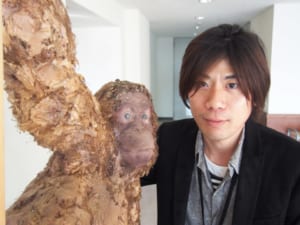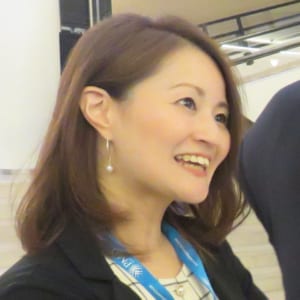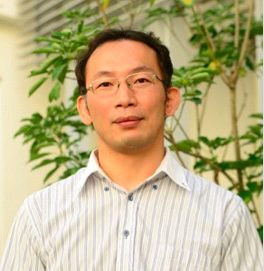The researcher's "hypothesis" is the source of knowledge (Part 1)
2019.12.21Session Report of the 8th Main Conference of the Association of Hyperdifferent Fields
Exploring the Origins of Knowledge - Can Transcending Disciplinary Barriers Generate Valuable Ideas [PART 1
Session Partner: Focus Systems, Inc.
<Speakers
 Assistant Professor, Department of Genome Evolution, Division of Genomic Cell Research, Primate Research Institute, Kyoto University
Assistant Professor, Department of Genome Evolution, Division of Genomic Cell Research, Primate Research Institute, Kyoto University
Mr. Masanori Imamura
Born in Takaoka City, Toyama Prefecture. Doctor of Medicine. After spending time as a student at the Faculty of Science, Kanazawa University, Nara Institute of Science and Technology, Graduate School of Medicine, Kyoto University, and Mitsubishi Chemical Life Science Institute, he worked as a Project Assistant Professor at Shiga University of Medical Science, Project Assistant Professor at Keio University School of Medicine, and a Visiting Researcher at RIKEN before assuming his current position in 2013. He has been working on human evolution and postnatal development from a stem cell perspective. He has received Life Technologies Japan Award (18th), On-Chip Biotechnologies Award (24th), SCREEN Holdings Award (29th), and L-RAD Award (36th) as the LIVERNESS Research Fund.
Laboratory websitehttp://www.pri.kyoto-u.ac.jp/sections/molecular_biology/member/imamura.html
 Associate Professor, Faculty of Education, Shiga University / Director, Eve Care Co.
Associate Professor, Faculty of Education, Shiga University / Director, Eve Care Co.
Masako Ohira
Completed the doctoral course at Osaka University Graduate School of Medicine in 2011. In the same year, he became a researcher at Nagaoka University of Technology's Center for the Development of Top Runners in the Fusion of Industry, Academia, and Government. He became a lecturer at the Faculty of Education, Shiga University in the same year and an associate professor at the same university in 2015. Since his graduate school days, he has been consistently engaged in research on stress evaluation using hormones in saliva. In recent years, he has been engaged in research and development of methodologies for stress assessment that do not use saliva, such as psychological stress assessment using biochemicals derived from body tissue fluid, nails, and hair. D. in Medicine.
 Project Associate Professor, Department of Tissue and Cell Design, Osaka University Graduate School of Medicine
Project Associate Professor, Department of Tissue and Cell Design, Osaka University Graduate School of Medicine
Technical Advisor, MyOrridge, Inc.
Mr. Kazunari Minami
D. in March 2003 from the Department of Neurophysiology, Division of Biophysics, Department of Biological Sciences, Faculty of Science, Kyoto University. He has developed low-cost and stable cell differentiation culture media and cell culture methods using novel compounds, and is conducting research and development for the mass production and stable supply of high-quality cardiomyocytes from iPS cells. Using this novel culture technology, he aims to lay the foundation for practical use of higher-order cellular tissues. 2016, he became a technical advisor to MyOridge, Inc. a bio-venture for mass culture of iPS cell-derived cardiomyocytes. 2017, he became a Project Associate Professor at Osaka University Graduate School of Medicine, Department of Collaborative Research in Tissue and Cell Design.
.
 Representative Director, President and COO, Liverness, Inc.
Representative Director, President and COO, Liverness, Inc.
Shuichiro Takahashi
D. (Life Sciences), Graduate School of Frontier Sciences, The University of Tokyo. He has been involved in RIVANESS since its establishment. After completing his graduate studies, he continued his research activities as a faculty member at the University of Tokyo, while at the same time he established a research institute at RIVANESS and built the foundation of its research and development business. He devised the business model of "Liberness Research Grant," a unique research grant, and "L-RAD," a database of unutilized research ideas, and has initiated many open innovation projects involving industry, academia, and education.
The researcher's "hypothesis" is the source of knowledge (Part 1)
(Takahashi)
First, I would like to share with you the thoughts that led me to conduct this session, turning it into a self-introduction. My name is Shuichiro Takahashi. I am the president of Liverness, but I was originally a researcher at a university. I studied the infectivity of plant diseases using molecular biology methods in the field of plant pathology. After I got my doctorate, I stayed on at the university to work on a project to build a plant hospital, and in my second year of my master's degree, I started RIVANES with my colleagues. So, in a sense, I was going back and forth between industry and the university. However, my base was still at the university doing research, so I was thinking about how to apply the "knowledge" at the university to society.
I personally feel that academia still has tremendous potential. And I would like to expand that potential beyond the framework of intellectual property and existing industry-academia collaboration. I think the value of researchers is not only intellectual property. There must be great results, considerations, and experiments before that, and surely there must be a great "hypothesis" even before that. That hypothesis is the value of the researcher. And I believe that the value of academia is the function of testing various hypotheses in a roundabout way, mainly using taxpayer funds and through industry-academia collaboration. Right now, you can find out about intellectual property and papers by searching databases, but there is no way to find out what hypotheses are working. That is why I opened a database called "Japanese-research.com" and a website of the same name a few years ago. This is a database that shows what kind of money went to what kind of professors, whether it be JSPS, JST, the Ministry of Health, Labor and Welfare, the National Agricultural Research Organization, and so on. We have collected all the budgets from these organizations and created a system that allows you to search for research themes, or in other words, what kind of hypotheses are being pursued in Japan. This is free of charge, so please take a look. I collected all of the hypotheses worth 700 billion yen, and at first I thought, "Now I understand the power of universities.
But in fact, the ideas for the actual work being done within the university are still in their infancy. For example, in the case of experimental work, it is often master's and doctoral students and post-doctoral researchers who are running the lab right now. But they don't have a researcher number, so there is no way to reach them. So we started the LIBERNESS Research Fund, which is a research fund that anyone under 40 years of age, even master's students, can apply for. 500,000 yen is a small amount, but it is a framework that allows young graduate students and others to propose more and more ideas by working together with industry to establish a research fund.
I also noticed one more thing: the grant-in-Aid for Scientific Research has an acceptance rate of 25%. Don't you think the yield rate is too low? So now, at RIVANES, we have created a new name, Elrad, by taking the letter "Elrad" and adding the "L" of RIVANES, which would probably make you laugh if you were a researcher. I have received nearly 1,000 ideas from various professors. In other words, we now have a mechanism to collect hypotheses that could not be sent for validation.
There has been a pleasant change in the way we do these things: 10 years ago, companies were interested in the good results, intellectual property, ventures, and in short, the tasty profits generated by researchers. However, I feel that now they are more interested in upstream, high-quality hypotheses, and want to approach the research together with us from there. I think the center of gravity in the context of so-called "open innovation" is more and more upstream. As someone who came out of a university, this is already an opportunity for me. If more and more people in industry become interested in the source of knowledge, which is also the subject of today's talk, I think we can do something new.
If this happens, I think the role, the way, and the shape of universities will change. That is why today we have invited professors who have been active in academia, such as by conducting research at universities, starting companies, and receiving the "LIBERNESS" research grant I mentioned earlier. We would like to think about how academia and industry can work together to create business, or if not business, how new hypotheses, such as the source of knowledge, can be increased and expanded. Now, I would like to start the discussion by having the three professors introduce themselves. First, I would like to start with Dr. Minami of Osaka University, who is sitting next to me. I look forward to working with you.
(South)
I have been doing research and development at Kyoto University for a long time, and have been studying induction of cardiomyocyte differentiation since about 12 years ago. 3 years ago, with the help of Liverness, I established a venture company, "BioRidge Inc. I have also been involved in cardiac regenerative medicine at Osaka University for the past two years.
First of all, I would like to introduce the amazing iPS cells. These cells are pluripotent and proliferate very rapidly, and after 3 months of culture, they can be increased to the equivalent of 100 earth masses. In other words, in principle, organs such as the heart, liver, brain, and kidneys can be created that are equivalent to the mass of 100 Earth molecules.
I mentioned that I am involved in cardiac regenerative medicine because cardiac disease is the leading cause of death in the world and there is a great need for it, and because there is no other way to create regenerative medicine for the heart than from iPS cells. However, in the course of our research, we were confronted with a certain problem: It has been possible to produce cardiomyocytes from iPS cells for 10 years, but at a very high cost. However, the cost is very high. The commercially available cardiomyocytes cost about 10 million yen per gram at the retail price. Therefore, to create a whole heart weighing 300 grams, it would cost 3 billion yen. No matter how much the number of iPS cells could be increased infinitely, cost would be a major issue. Therefore, we developed a technology to replace cytokines and proteins necessary for culture with low molecular weight compounds and amino acids, and created a system that can stably induce cardiomyocytes at a very low cost. Since the cost of culture medium can be reduced to a maximum of one-hundredth, we were able to reduce the cost of materials alone from 3 billion yen to 30 million yen for a single heart. We think this is a realistic figure. Moreover, when we examined the properties of the cells, we found that they were relatively more mature than conventional cardiomyocytes.
A venture launched three years ago based on intellectual property from Kyoto University is developing a compound screening system using iPS cardiomyocytes to support drug discovery, which can monitor the pulsation of iPS cardiomyocytes and detect side effects of drug biogenesis. Meanwhile, Osaka University is using a protein-free differentiation method to automatically produce and organize cardiomyocytes in bioreactors. We are also engaged in research and development, such as using our collaborator's nanofiber technology to create thick cardiomyocyte tissue, which can then be transferred to myocardial infarction for treatment. That is all.

